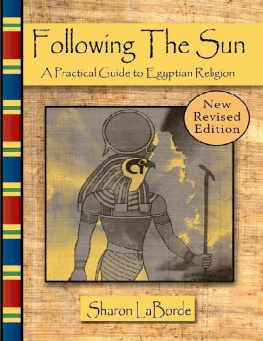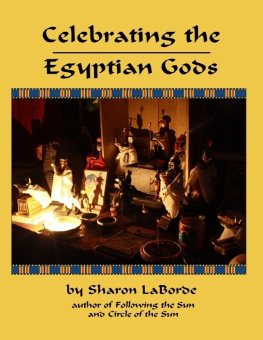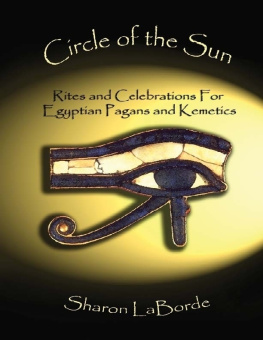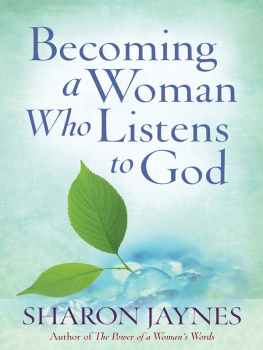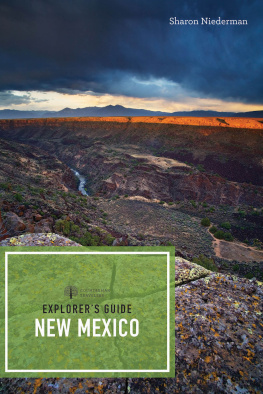Sharon LaBorde - Following the Sun: A Practical Guide to Egyptian Religion
Here you can read online Sharon LaBorde - Following the Sun: A Practical Guide to Egyptian Religion full text of the book (entire story) in english for free. Download pdf and epub, get meaning, cover and reviews about this ebook. year: 2016, publisher: Lulu, genre: Science fiction / Religion. Description of the work, (preface) as well as reviews are available. Best literature library LitArk.com created for fans of good reading and offers a wide selection of genres:
Romance novel
Science fiction
Adventure
Detective
Science
History
Home and family
Prose
Art
Politics
Computer
Non-fiction
Religion
Business
Children
Humor
Choose a favorite category and find really read worthwhile books. Enjoy immersion in the world of imagination, feel the emotions of the characters or learn something new for yourself, make an fascinating discovery.
- Book:Following the Sun: A Practical Guide to Egyptian Religion
- Author:
- Publisher:Lulu
- Genre:
- Year:2016
- Rating:3 / 5
- Favourites:Add to favourites
- Your mark:
- 60
- 1
- 2
- 3
- 4
- 5
Following the Sun: A Practical Guide to Egyptian Religion: summary, description and annotation
We offer to read an annotation, description, summary or preface (depends on what the author of the book "Following the Sun: A Practical Guide to Egyptian Religion" wrote himself). If you haven't found the necessary information about the book — write in the comments, we will try to find it.
Following the Sun: A Practical Guide to Egyptian Religion — read online for free the complete book (whole text) full work
Below is the text of the book, divided by pages. System saving the place of the last page read, allows you to conveniently read the book "Following the Sun: A Practical Guide to Egyptian Religion" online for free, without having to search again every time where you left off. Put a bookmark, and you can go to the page where you finished reading at any time.
Font size:
Interval:
Bookmark:
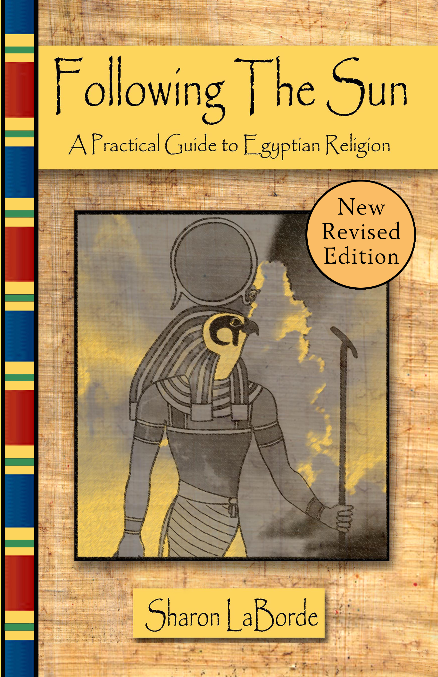 Following the Sun : A Practical Guide to Egyptian Religion
Following the Sun : A Practical Guide to Egyptian ReligionSharon LaBorde
Following the Sun : A Practical Guide to Egyptian Religion . copyright Sharon LaBorde. All rights reserved.
First edition , 2010 .
Revised edition , 201 . All rights reserved.
ISBN: 978-1-365-87722-3
Acknowledgements
This book could never have happened without the assistance, encouragement, and opportunities that were afforded me by some very special people. These "guilty parties" include Nic M. and Trixie Davis, who invited me to that first Pagan Pride Day (I know Ken was watching over all of us); Krys Garnett, who generously provided photos of major Egyptological sites and scans of obscure books (a 'voice offering' to Ra and all your patrons); the various online communities of which I have been part, including Children of Kemet , Het Shemsu , and the Following the Sun forum ; and particularly to Tony Kail and my dear friend Matt Kirkby, who pointed me in the right direction when it came time to publish.
And most especially to Daryn my husband, my beta-reader, my editor, my cheerleader my everything!
To the Osiris, King NebkheperuRa, son
of R a Tutankhamun, that he may celebrate millions
of jubilees into eternity
 Preface to the New Edition
Preface to the New EditionFollowing the Sun was first published in June 2010, just six months after Richard Reidys work on Kemetic Reconstructionism , Eternal Egypt , was published. I would like to think that these two books represent for Kemetic Pagans what Margot Adlers Drawing Down the Moon and Starhawks The Spiral Dance have for a previous generation of Pagans; both of those books were first published on Samhain (Halloween) 1979, and together they exposed many readers to Paganism, Wicca and Goddess spirituality for the first time. Indeed, in the years since I first released Following the Sun , I have spoken to or corresponded with many Kemetics and Egyptian Pagans who keep both Following the Sun and Eternal Egypt on their bookshelves. But it is still too soon, as yet, to know fully whether this comparison will ring true - even though seven years, as measured on the Internet, is a rather long time.
During that time, both society at large and the Kemetic scene have further evolved. Technologies that were already present in 2010 - blogging, YouTube and social media in pa rticular - have supported an up swell of Pagans practicing some form of Kemetic, or Egyptian, Paganism. (The subtle difference s of meaning between these two terms will also be revisited in this edition.) While technically these people could be termed Independent Kemetics, because they do not claim membership in an established community such as Church of the Eternal Source; Kemetic Orthodoxy; the Kemetic [Reconstructionist] Temple co-founded by Richard Reidy; or the Ausar-Auset Society (among others), these unaffiliated practitioners still communicate with fellow Pagans online, and their beliefs and practices are influenced by this collective experience. This new edition of Following the Sun owes much to the concerns they have expressed.
One social issue that has grown painfully urgent in recent years and holds a direct bearing upon Kemeticism is racial disparity, particularly in the United States. The Black Lives Matter movement first formed to address continued race discrimination in law enforcement and the justice system, but its message has been applied to many other aspects of life, including Kemeticism. This renewed awareness has not come without controversy. A deep divide still separates Afrocentric Kemetic beliefs and practices from other forms of Kemeticism; one need only peruse Kemetic video listings on YouTube to see these stark contrasts firsthand. While addressing that divide in greater detail reaches beyond the scope of this book, the discussion of ethnicity in ancient Egypt found in Chapter Two has been greatly expanded. Recent research on Nubia, some of it published after the first edition of Following the Sun appeared , has been incorporated in order to give a more inclusive answer to the question of racial identity in ancient Egypt.
Kemetic Paganisms relation to Wicca, and comparative practices between the two, has also been reconsidered. While Wicca represents only one form of modern Paganism, within Wicca itself one finds a kaleidoscope of beliefs and practices. No two covens or circles are alike, even if one coven formed as an offshoot of another. General observations about Wicca in the first edition reflected my exposure to a limited nu mber of Wiccan practices; in this new edition, I can relate a broader spectrum .
T he section on holiday observances in Part Two ha s been expanded in response to feedback from readers. While my second book, Circle of the Sun , includes detailed rituals meant for use by either Kemetic or Wiccan readers, I am including more background information here in Following the Sun especially for Egyptian-themed (or Tameran) Wiccans to use in adapting the Wheel of the Year. Kemetic practitioners could also find it useful material for working with members of open circles or eclectic Pagan groups. One theme expressed in both books that, to some extent, still holds true today is the distance between other forms of Paganism and Kemeticism/Egyptian Paganism. Despite our growing numbers, we still find relatively little mention in mainstream discussions of Paganism. My continued hope is that together we can change that oversight, and claim our place among the mainstream of modern Pagan faiths.
One critique of Following s first edition, however, will not make its way into this revision. All of my historical material is researched to the fullest extent of my ability; but with only one exception, I deliberately forego the use of footnotes in my text. My sources can be found either from direct citation or in my bibliography. I n my experience, footnotes not only make reading more cumbersome, but also frequently tell me nothing that the bibliography doesnt already. As Egyptologist Ann Macy Roth wrote in her article Ancient Egypt in America: Claiming the Riches , myriad footnotes do not in themselves constitute scholarship. My aim has always been to make legitimate, up-to-date research on ancient Egypt easy for non-academics to read, understand, and enjoy. Dressing up my writing in footnotes and lengthy citations does a disservice to that goal and to my audience . Following the Sun , Circle of the Sun , and however many books will eventually follow them , are all first and foremost intended to be a benefit to their readers.

I tend to be the oddball wherever I go. Whatever the situation, I always seem to be either too young, too educated, too eclectic, or else too something unique compared to the rest of my group. I've even managed to throw members of a local Pagan community surely a bastion of counter - culturalism if ever society has one for a complete loop. Our crowning moment of con-fusion came during a celebration of Mabon, the autumnal equinox. While the service was hosted by an area Wiccan coven, free spirits of all stripes were in attendance: Christians, Druids, "non-denominational" Pagans, Germanic Heathens, and myself, the token devotee of Egyptian deities. Before the ceremony got underway, one of our regulars made info rmal intro ductions for a newcomer. She gestured toward each person where it applied:
Font size:
Interval:
Bookmark:
Similar books «Following the Sun: A Practical Guide to Egyptian Religion»
Look at similar books to Following the Sun: A Practical Guide to Egyptian Religion. We have selected literature similar in name and meaning in the hope of providing readers with more options to find new, interesting, not yet read works.
Discussion, reviews of the book Following the Sun: A Practical Guide to Egyptian Religion and just readers' own opinions. Leave your comments, write what you think about the work, its meaning or the main characters. Specify what exactly you liked and what you didn't like, and why you think so.

